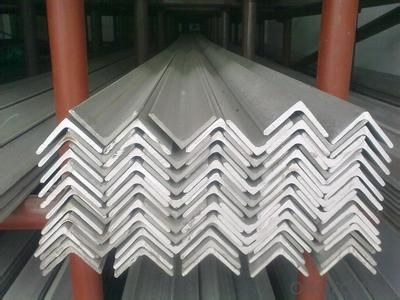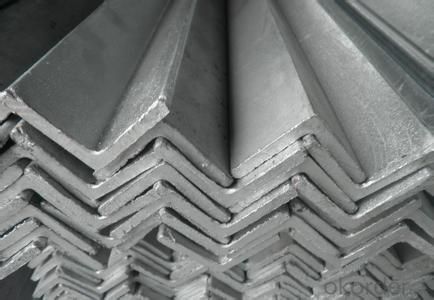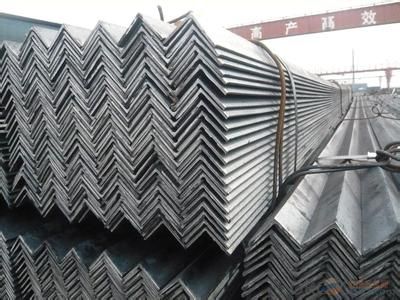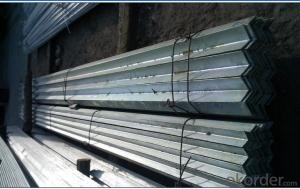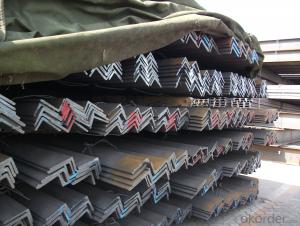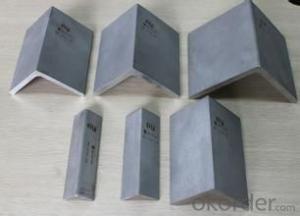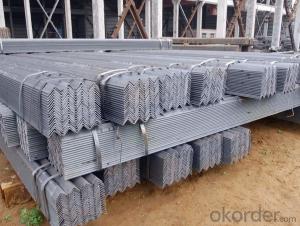Equal Angle Steel or Unequal Angle Steel JIS G3192
- Loading Port:
- Tianjin
- Payment Terms:
- TT OR LC
- Min Order Qty:
- 25 m.t.
- Supply Capability:
- 200000 m.t./month
OKorder Service Pledge
OKorder Financial Service
You Might Also Like
Specification
Product Description:
OKorder is offering Equal Angle Steel or Unequal Angle Steel JIS G3192 at great prices with worldwide shipping. Our supplier is a world-class manufacturer of steel, with our products utilized the world over. OKorder annually supplies products to European, North American and Asian markets. We provide quotations within 24 hours of receiving an inquiry and guarantee competitive prices.
Product Applications:
According to the needs of different structures, Angle can compose to different force support component, and also can be the connections between components. It is widely used in various building structures and engineering structures such as roof beams, bridges, transmission towers, hoisting machinery and transport machinery, ships, industrial furnaces, reaction tower, container frame and warehouse etc
Product Advantages:
OKorder's Equal Angle Steel or Unequal Angle Steel JIS G3192 are durable, strong, and resist corrosion.
Main Product Features:
· Premium quality
· Prompt delivery & seaworthy packing (30 days after receiving deposit)
· Corrosion resistance
· Can be recycled and reused
· Mill test certification
· Professional Service
· Competitive pricing
Product Specifications:
Manufacture: Hot rolled
Grade: Q195 – 235
Certificates: ISO, SGS, BV, CIQ
Length: 6m – 12m, as per customer request
Packaging: Export packing, nude packing, bundled
Sizes: 25mm-250mm | ||||||||||||
a*t | ||||||||||||
25*2.5-4.0 | 70*6.0-9.0 | 130*9.0-15 | ||||||||||
30*2.5-6.6 | 75*6.0-9.0 | 140*10-14 | ||||||||||
36*3.0-5.0 | 80*5.0-10 | 150*10-20 | ||||||||||
38*2.3-6.0 | 90*7.0-10 | 160*10-16 | ||||||||||
40*3.0-5.0 | 100*6.0-12 | 175*12-15 | ||||||||||
45*4.0-6.0 | 110*8.0-10 | 180*12-18 | ||||||||||
50*4.0-6.0 | 120*6.0-15 | 200*14-25 | ||||||||||
60*4.0-8.0 | 125*8.0-14 | 250*25 | ||||||||||
FAQ:
Q1: What makes stainless steel stainless?
A1: Stainless steel must contain at least 10.5 % chromium. It is this element that reacts with the oxygen in the air to form a complex chrome-oxide surface layer that is invisible but strong enough to prevent further oxygen from "staining" (rusting) the surface. Higher levels of chromium and the addition of other alloying elements such as nickel and molybdenum enhance this surface layer and improve the corrosion resistance of the stainless material.
Q2: Can stainless steel rust?
A2: Stainless does not "rust" as you think of regular steel rusting with a red oxide on the surface that flakes off. If you see red rust it is probably due to some iron particles that have contaminated the surface of the stainless steel and it is these iron particles that are rusting. Look at the source of the rusting and see if you can remove it from the surface.
Q3: How do you package the angle steel when shipping?
A3: All goods are packed in bundles with steel strips and shipped by container or break bulk.
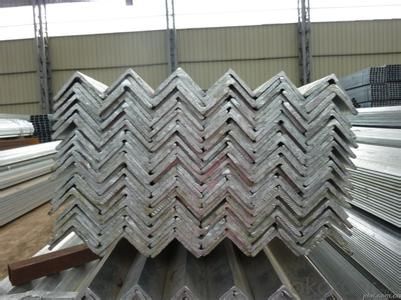
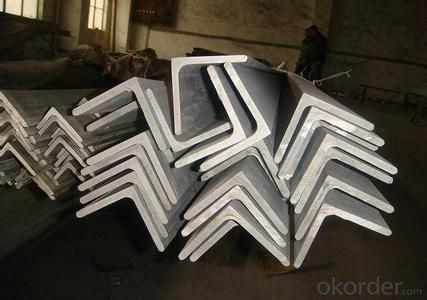
- Q: What are the different connections used with steel angles?
- There are various connections available for steel angles, depending on the specific application and structural needs. Some commonly used connections for steel angles include the following: 1. Welded connections: Steel angles can be connected through welding, where the edges of the angles are melted and joined using arc welding or MIG welding. Welded connections offer durability and strength, but they require skilled labor and may take time to complete. 2. Bolted connections: Another option is to connect steel angles using bolts. This involves drilling holes through the angles and inserting bolts, securing them in place with nuts and washers. Bolted connections are relatively easy and quick to install, and they allow for easy disassembly if necessary. However, they may not be as strong as welded connections and may require periodic inspection and tightening. 3. Riveted connections: Steel angles can also be connected using rivets. This involves drilling holes through the angles and inserting rivets, which are then hammered or pressed to secure them in place. Riveted connections offer reliability and strength, but they are less commonly used nowadays due to more efficient and cost-effective connection methods. 4. Clip connections: An alternative is to use metal clips or brackets to connect steel angles. These pre-fabricated clips are bolted or welded to the angles, allowing for easy repositioning or removal if needed. Clip connections are often used in situations where adjustability or flexibility is required. 5. Angle connections: In some cases, steel angles can be connected to each other using additional angles. These angles are typically bolted or welded together, providing increased strength and stability. Angle connections are commonly used in structural applications that require additional reinforcement or support. When selecting the appropriate connection method for steel angles, it is crucial to consider project-specific requirements such as load-bearing capacity, structural design, and maintenance. Consulting with a structural engineer or construction professional is recommended to ensure the most suitable connection method is chosen for the specific application.
- Q: Can steel angles be used for handrail supports?
- Indeed, handrail supports can utilize steel angles. In the realm of construction, steel angles are frequently employed to furnish structural support and ensure stability. These L-shaped steel components possess remarkable strength and durability. Once carefully installed and firmly fastened, steel angles can proficiently uphold handrails, furnishing a robust framework for individuals to lean on or grasp whilst ascending stairs or traversing elevated surfaces. The selection of steel angles for handrail supports hinges on considerations such as the desired load capacity, design specifications, and adherence to local building codes.
- Q: What are steel angles?
- Construction and engineering projects often utilize steel angles, which are a type of steel structural shape. These angles are L-shaped beams with legs of either equal or unequal length, forming a 90-degree angle. Typically made from hot-rolled steel, they can be found in a variety of sizes and thicknesses. Steel angles offer versatility and have many uses. They are commonly employed as framing elements in buildings and bridges, providing necessary support and stability. In addition, they can serve as reinforcement in concrete structures or as brackets and supports for equipment and machinery. One of the significant advantages of steel angles is their strength and durability. They are designed to withstand heavy loads and maintain structural integrity. Furthermore, steel angles are resistant to corrosion, making them suitable for outdoor applications and environments with high levels of moisture or chemical exposure. Steel angles are available in different grades, each with its own mechanical properties and characteristics. This allows engineers and designers to select the most suitable angle for a given project's requirements. In conclusion, steel angles are crucial components in construction and engineering. They offer strength, stability, and versatility across a wide range of applications. Whether providing structural support or reinforcement, steel angles play a vital role in ensuring the integrity and safety of various structures.
- Q: What is the maximum spacing for steel angles in a support structure?
- The maximum spacing for steel angles in a support structure depends on several factors including the load being supported, the size and thickness of the angles, and the specific design criteria. In general, the spacing between steel angles should be determined by the structural engineer or designer based on the maximum allowable deflection and stress criteria for the given application. Steel angles are commonly used in support structures due to their high strength and versatility. They can provide structural stability and support to various types of loads. However, excessive spacing between steel angles can lead to increased deflection and stress on the structure, potentially compromising its integrity. To determine the maximum spacing, the engineer will consider the load-bearing capacity of the steel angles, the anticipated load distribution, and any applicable building codes or industry standards. The specific design criteria will dictate the allowable deflection and stress limits, which will then be used to calculate the appropriate spacing between the angles. It is important to note that different types of support structures may have different maximum spacing requirements. For instance, in a roof truss system, the maximum spacing between steel angles may be smaller compared to a mezzanine support structure. Additionally, the maximum spacing may vary depending on whether the angles are used as primary or secondary support members. Ultimately, the maximum spacing for steel angles in a support structure should be determined through a thorough engineering analysis, taking into account the specific project requirements and safety factors. It is always recommended to consult with a structural engineer or design professional to ensure the support structure meets all necessary criteria for safety and performance.
- Q: How do you transport and ship steel angles?
- Steel angles can be transported and shipped using various methods, depending on their size and quantity. Typically, smaller steel angles can be bundled and packed onto pallets or in crates, which are then loaded onto trucks or shipping containers for transportation. For larger and heavier steel angles, specialized equipment such as flatbed trucks or trailers with cranes may be required. Additionally, steel angles can also be shipped in bulk, either loose or in coils, using bulk carriers or barges. It is important to ensure proper packaging, securing, and labeling to ensure safe and efficient transportation and shipping of steel angles.
- Q: Are steel angles resistant to impact or vibration?
- Steel angles exhibit resistance to both impact and vibration. The strength and toughness of steel make it highly resistant to impact, as it is capable of absorbing and distributing the force generated by an impact, thereby preventing any structural damage. Additionally, steel angles possess a high natural frequency, enabling them to withstand vibrations without experiencing significant deformation or failure. Nevertheless, the resistance of steel angles to impact and vibration may vary depending on factors such as the specific grade and thickness of the steel, as well as the intensity and duration of the impact or vibration. Therefore, it is crucial to carefully consider the specific requirements and conditions of the application when evaluating the suitability of steel angles for impact and vibration resistance.
- Q: Are steel angles fire-resistant?
- Steel angles possess a certain degree of fire resistance. Steel, as a non-combustible substance, does not ignite or contribute to the combustion process. Its exceptional melting point, typically hovering at 1370°C (2500°F), ensures that it retains its structural integrity even when subjected to high temperatures. Nevertheless, it is crucial to recognize that the fire resistance of a structure or component reliant on steel angles hinges on various factors, such as the design, dimensions, and arrangement of said angles, as well as the implementation of fire protection measures. Fire-resistant coatings, fireproofing substances, or fire-resistant insulation can be employed to bolster the fire resistance of steel angles. These supplementary fire protection methods have the capacity to provide a certain level of insulation, impeding the transfer of heat to the steel and prolonging the time it takes for the steel to reach its critical temperature. This grants occupants more time to evacuate the premises and affords firefighters an extended period to manage the fire. In conclusion, steel angles inherently possess fire resistance due to the properties of steel. However, the implementation of appropriate fire protection measures can augment their fire resistance capabilities.
- Q: Can steel angles be used as structural supports?
- Indeed, structural supports can be provided by steel angles. Construction and engineering projects frequently employ steel angles due to their remarkable strength and stability. Their distinctive L-shape design renders them perfectly suited for lending support and ensuring structural integrity to various structures. Buildings, bridges, and other infrastructure projects often incorporate steel angles as beams, braces, or supports. These angles are capable of bearing heavy loads and resisting bending and compression forces, thereby establishing themselves as a dependable choice for structural support. Moreover, the ease of fabrication and installation associated with steel angles renders them a cost-effective solution for construction purposes.
- Q: What are the different types of steel angles used in machinery?
- There are several different types of steel angles that are commonly used in machinery. One of the most common types is the equal-leg angle, also known as L-shaped or L-angle steel. This angle has equal dimensions on both sides, forming a 90-degree angle. It is commonly used in machinery to provide structural support and stability, as well as to reinforce joints and connections. Another type is the unequal-leg angle, which has different dimensions on each side, resulting in an uneven angle. This type of angle is often used in machinery where specific weight distribution or load-bearing requirements need to be met, as it allows for greater flexibility in design. Additionally, there are also rounded steel angles, also known as rounded corner angles or round bars. These angles have rounded edges instead of sharp corners, making them ideal for machinery applications where safety is a concern, as they reduce the risk of injury from sharp edges. Furthermore, there are slotted steel angles, which have one or more holes or slots along their length. These slots allow for easy adjustment and mounting of components, making them suitable for machinery that requires frequent modifications or customization. Lastly, stainless steel angles are another type commonly used in machinery. Stainless steel offers excellent corrosion resistance, making it ideal for machinery that operates in harsh or corrosive environments, such as marine or chemical applications. Overall, the choice of steel angle in machinery depends on the specific requirements of the application, including structural needs, load-bearing capacity, safety considerations, and environmental factors.
- Q: How do you inspect and measure the dimensions of a steel angle?
- To inspect and measure the dimensions of a steel angle, the following steps can be followed: 1. Tools required for the task are a measuring tape or ruler, a protractor, and a square. 2. Begin by examining the length of the steel angle. Place one end of the measuring tape or ruler on one side of the angle and extend it to the opposite side. Make sure the measuring tape is straight and aligned with the edge of the angle. Read the measurement in inches or millimeters to determine the length. 3. Proceed to measure the width or thickness of the angle. Position the measuring tape or ruler perpendicular to the length of the angle and measure the distance between the two parallel sides. This will provide the width measurement. 4. To measure the height or depth of the angle, position the measuring tape or ruler perpendicular to the width measurement. Again, ensure that the measuring tape is aligned with the edge of the angle and measure the distance between the two sides. This will yield the height measurement. 5. To verify the accuracy of the angle being 90 degrees, employ a square. Place the square against one side of the angle and ensure alignment with the adjacent side. Check if the corner of the angle fits perfectly within the square. If it does, the angle is indeed 90 degrees. If not, adjustments may be necessary. 6. Lastly, if the angle of the steel angle needs measurement, a protractor can be employed. Align one side of the protractor with one side of the steel angle and observe where the other side intersects with the protractor scale. Read the angle measurement to determine the exact angle. By adhering to these steps and utilizing the appropriate tools, one can effectively inspect and measure the dimensions of a steel angle.
Send your message to us
Equal Angle Steel or Unequal Angle Steel JIS G3192
- Loading Port:
- Tianjin
- Payment Terms:
- TT OR LC
- Min Order Qty:
- 25 m.t.
- Supply Capability:
- 200000 m.t./month
OKorder Service Pledge
OKorder Financial Service
Similar products
Hot products
Hot Searches
Related keywords



